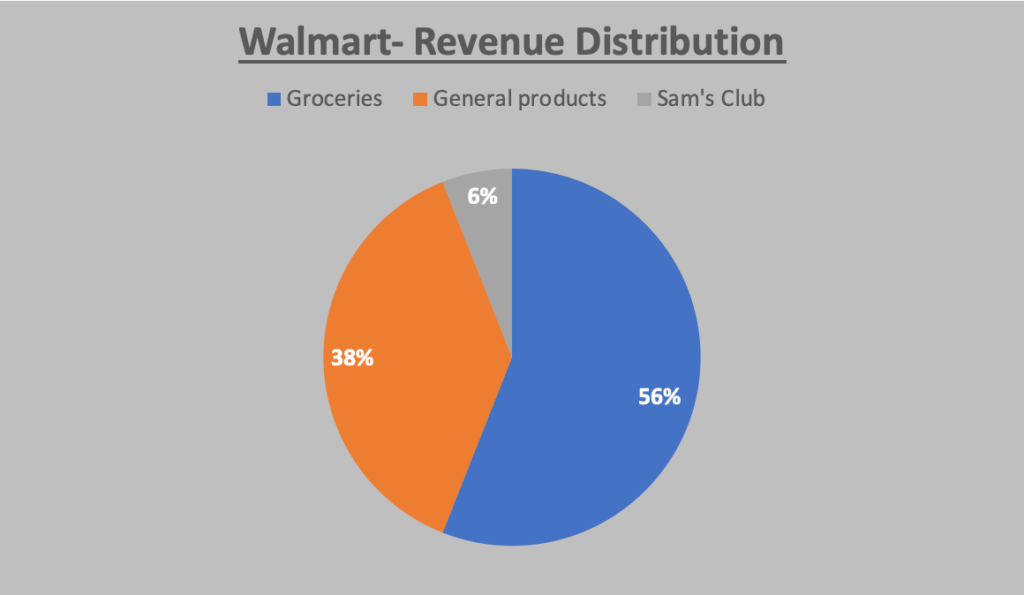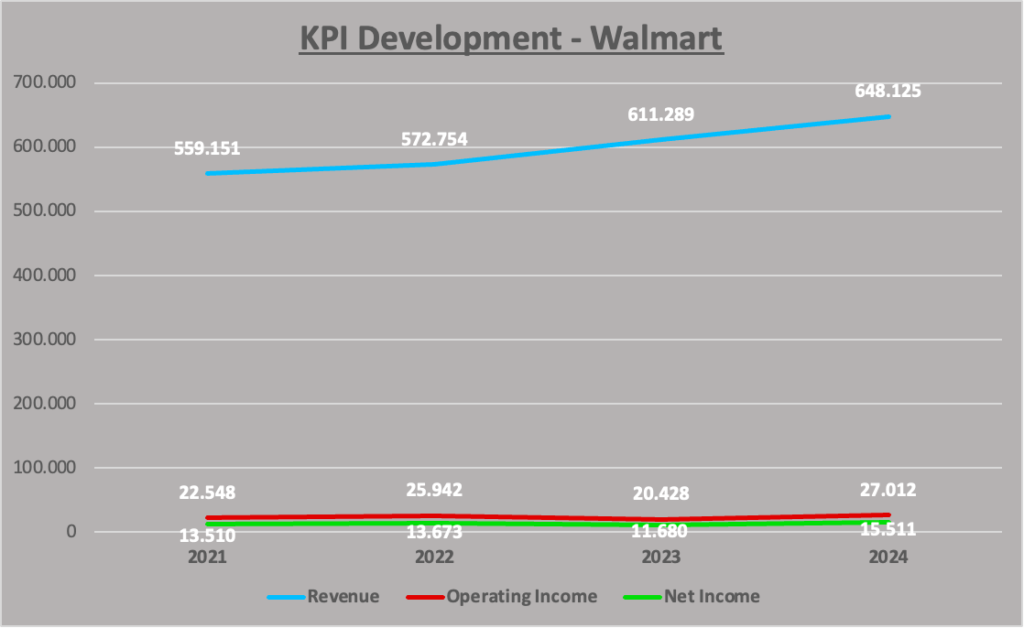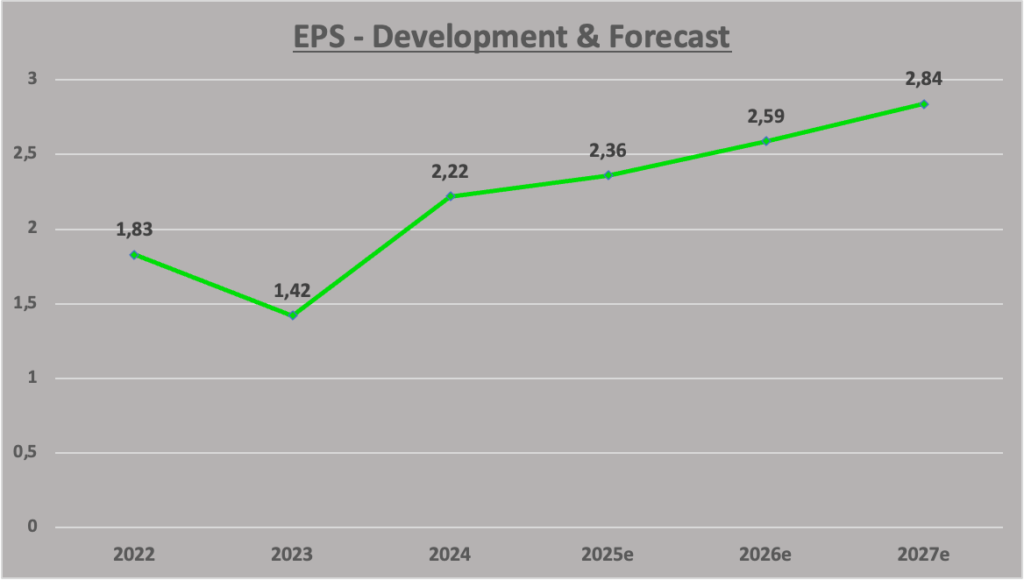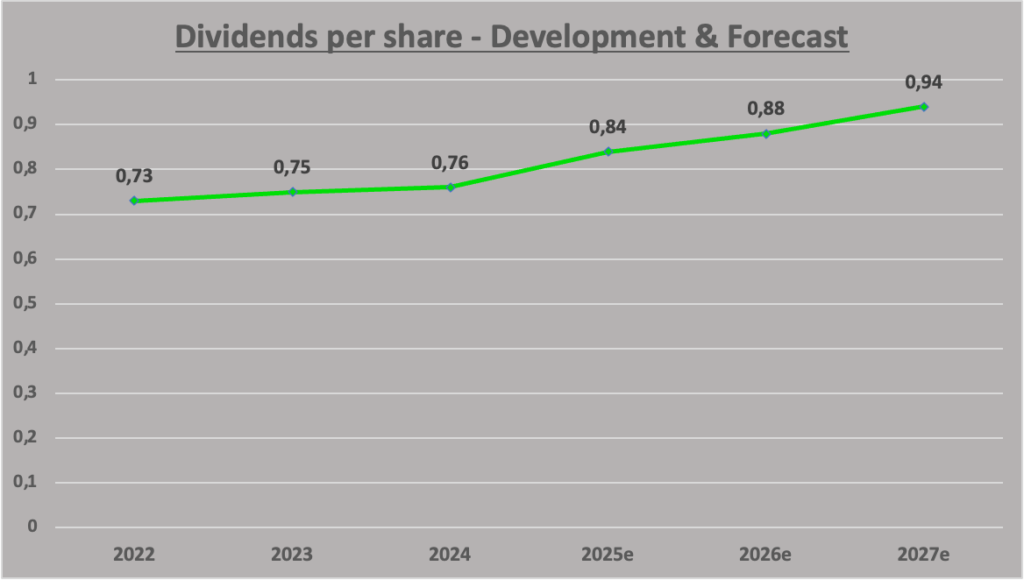In this stock analysis we will learn everything about the Walmart stock. We will analyze Walmart’s profitability, financial security & growth and in the end we will evaluate the share price. You can then decide whether Walmart is a suitable investment for you or not.
Company Profile
Walmart Inc. is a multinational retail giant headquartered in Bentonville, Arkansas. Founded in 1962 by Sam Walton, it has grown from a single discount store into the world’s largest company by revenue according to the Fortune Global 500 list (as of October 2022).
Walmart operates under three main segments:
- Walmart U.S.: This segment comprises the chain of Supercenters, Discount Stores, and Neighborhood Markets across the United States. These stores offer a wide variety of general merchandise, groceries, and other household essentials.
- Walmart International: This segment consists of Walmart’s stores in 19 countries outside the U.S. These stores cater to local preferences and offer a mix of products similar to Walmart U.S.
- Sam’s Club: Sam’s Club is a membership-only warehouse club chain offering bulk quantities of groceries, general merchandise, and business supplies at discounted prices.
Walmart boasts an extensive global presence with over 10,500 stores and numerous eCommerce websites across its various markets. It employs a staggering 2.1 million associates worldwide, making it the world’s largest private employer (after the U.S. and Chinese armies).
Walmart’s core mission is to provide everyday essentials at everyday low prices. They achieve this through efficient supply chain management, bulk purchasing, and strong negotiating power with suppliers.
While known for its brick-and-mortar stores, Walmart is constantly innovating and expanding its e-commerce presence.They offer online shopping with convenient delivery and pick-up options, creating a seamless omnichannel experience for customers.
Walmart remains a retail powerhouse, continuously adapting to meet the evolving needs of its customers. With its focus on value, innovation, and global reach, Walmart is sure to be a dominant force in the retail landscape for years to come.
Revenue Distribution
Walmart divides its business into three divisions:

The pie chart you sent shows a breakdown of Walmart’s revenue distribution based on product category, not geographically. Here’s a breakdown of what the chart shows:
- Grocery (60%): This is Walmart’s largest revenue segment, likely due to the high frequency of grocery purchases and the chain’s focus on competitive grocery prices.
- General Products (38%): This category includes a wide range of merchandise, such as clothing, electronics,homeware, furniture, toys, and sporting goods.
- Sam’s Club (6%): Sam’s Club memberships provide access to bulk discounts on groceries and general merchandise,contributing a smaller portion of overall revenue.
Geographically the revenue can be divided in the following categories:
- Walmart U.S. (68%): This segment includes all Walmart stores and clubs within the United States.
- Walmart International (17%): This segment includes Walmart stores and clubs in all international markets.
- Sam’s Club (13%): This segment includes all Sam’s Club locations.
- Membership and Other Income (2%): This segment includes revenue from Walmart’s membership programs and other miscellaneous sources.
Predicting the exact future of Walmart’s revenue distribution is difficult, but here are some trends that might influence the shift:
- E-commerce Growth: Walmart’s online sales are a growing portion of their business. As online shopping becomes even more popular, the share of revenue from online channels is likely to increase.
- Grocery Delivery and Pick-up: The convenience of grocery delivery and pick-up services is gaining traction. If Walmart can effectively capture this market segment, it could potentially increase the grocery revenue share,especially within the U.S. segment.
- International Expansion: While Walmart is already a global giant, there’s still room for expansion in certain markets. If they successfully enter new territories or expand their presence in existing ones, the international segment’s revenue share could grow.
- Sam’s Club Evolution: Sam’s Club might need to adapt its membership model and product offerings to stay relevant. If they can attract a wider customer base or increase the average member spending, their revenue share might increase.
Competition
Walmart faces competition on several fronts, depending on the specific product category and shopping experience. Here are some of their biggest competitors:
Overall Retail:
- Amazon: The e-commerce giant is a major competitor, especially for general merchandise and with its growing grocery delivery presence.
- Costco: This membership warehouse club offers similar bulk discounts and competes directly with Sam’s Club.
Grocery:
- Kroger: A major grocery store chain with a strong presence in the U.S., particularly known for its private label brands.
- Target: While known for general merchandise, Target has also upped its grocery game, offering a curated selection at competitive prices.
Other Competitors:
- Department stores: Like Macy’s and Kohl’s, for specific apparel and homeware categories.
- Discount retailers: Dollar General and Dollar Tree compete for value-conscious shoppers seeking everyday essentials at rock-bottom prices.
- Specialty retailers: Home Depot and Lowe’s for home improvement supplies, Best Buy for electronics, etc.
The intensity of competition varies depending on the product category and location. Walmart’s advantage lies in its vast physical store network, strong brand recognition, and focus on value. However, competitors like Amazon and Target are constantly innovating and expanding their offerings, keeping Walmart on its toes.
Profitability – Walmart
The first analysis to determine the intrinsic value is profitability.
Stocks with a competitive advantage generate high profit margins, do not require a lot of capital and stand out from the competition. In other words, stocks with a competitive advantage are more profitable than the competition.
To determine this, we first look at the income statement, analyze it, compare the profit margins with the competition and calculate how capital-intensive the business is compared to the competition.
To do this, we take a closer look at the income statement and start by analyzing how much revenue was generated, what costs accrued and what profits were achieved as a result. Here is the income statement stream from Walmart:

In the last four quarters, Walmart generated sales of around $648 billion, with revenue costs of around $490 billion. The approximately $131 billion in operating expenses are almost entirely made of administrative costs. After taxes, Walmart achieved a profit of 15.5 billion dollars.
Profit Margins
The various margins are of particular interest in the income statement analysis. The higher the margins compared to the competition, the greater the competitive advantage. The emphasis here is on competitive comparison, as companies from the retail industry cannot be compared with technology companies such as Microsoft. A comparison only makes sense if the products and services are comparable.
Walmart achieves slightly worse margins than its competitors:
| Walmart | Costco | Amazon | Target | |
| Gross Margin | 24.38% | 12.38% | 16.32% | 27.63% |
| Operating Margin | 4.17% | 3.42% | 6,41% | 5.31% |
| Net Profit Margin | 2.39% | 2.73% | 5.29& | 3.85% |
Margins from the income statement give us an indication of the profitability of a company. Basically, it can be said that the better the margins compared to the competition, the higher the profitability and the greater the competitive advantage.
However, as already mentioned, the products and services must be comparable with each other. Even if there are many overlaps in this competitive comparison, they are all unique and a comparison should only be made with caution.
Return on Assets
Return on assets (ROA for short) is the most important key figure for analyzing a company’s profitability. ROA is calculated by dividing the profits by the total assets. It shows how much profit a company generates from its assets. The higher the ROA compared to the competition, the better the company’s earning power.
Here is the ROA comparison between Walmart and its competitors:
| Walmart | Costco | Amazon | Target | |
| ROA | 6.26% | 9.91% | 6.29% | 7.66% |
As you can see, Walmart has the lowest ROA. For now Walmart has no competitive advantage.
Financial Security – Walmart
After analyzing the profitability, the second analysis for determining the intrinsic value is the financial security of a company. This is because companies that are financially secure and solidly financed give us investors a level of security. While the income statement provides us with information about the operating business, the balance sheet shows us how the company is financed.
To assess the financial security of a company, it is important to look at the ratio between equity and debt. In addition, the company should be able to cope with short-term financial burdens. The debt to equity ratio and the cash ratio are two key figures that can help us with this.
The debt to equity ratio shows the relationship between long-term debt and equity. The cash ratio shows how well short-term liabilities are covered by cash, bank and similar assets. Here is the development of the mentioned KPIs for Walmart:
| Cash Ratio | Debt to Equity | |
| 2021 | 0.19 | 0.78 |
| 2022 | 0.17 | 0.69 |
| 2023 | 0.09 | 0.77 |
| 2024 | 0.11 | 0.73 |
This means that current liabilities are not well covered and the company is moderately self-financed. This is an indicator of an all right level of financial security. To put financial security into perspective, here is a comparison with the competition:
| Walmart | Costco | Amazon | Target | |
| Cash Ratio | 0.11 | 0.3 | 0.53 | 0.2 |
| Debt to Equity | 0.73 | 0.45 | 0.67 | 1.46 |
As this comparison clearly shows, Walmart has a low level of financial security. Compared to its competitors, its current liabilities are the worsed secured and its debt ratio is the second highest.
Growth – Walmart
Analyzing company performance is an important part of value investing. It makes it possible to draw conclusions for the future from the past. The income statement provides important information about the development of the company.
Here is the development of revenue, operating income and net income from 2021 to 2024:

In the period from 2021 to 2024, Walmart has achieved an increase in sales of +16%, with a slightly better operating growth of +20% combined with a profit increase of +15% to around 15.5 bn $.
Walmart’s growth compares not so good with its competitors:
| 2020 to TTM | Walmart | Costco | Amazon | Target |
| Revenue Growth | +16% | +49% | +49% | +15% |
| Operating Growth | +20% | +56% | +61% | +15% |
| Net Income Growth | +15% | +70% | +43% | -5% |
The development of KPIs can provide information about the future development of a company. Although past growth is no guarantee of future growth, companies with a strong performance will generally continue to grow in the future. Companies whose sales and profits are falling, on the other hand, will generally also fall in the future. To create a more accurate forecast, you should also consider the revenue distribution in addition to the KPI development.
Share Price & Forecasts
Now that we have analyzed and evaluated the Walmart share, it is time to assess the current price of the share.
The share price is determined by supply and demand. Supply is determined by the company and the shareholders. Demand is determined in the long term by the earnings per share. The more profit a share generates, the more interesting it is for investors.
The P/E ratio, also known as the price/earnings ratio, shows the relationship between the share price and the earnings per share. For example, a P/E ratio of 20 means that a share with a price of $20 has earnings per share of one dollar. (Price = P/E ratio * earnings per share)
The lower the P/E ratio, the better the investment. Unfortunately, this cannot be said across the board, as future developments and forecasts play a very important role.
Earnings per Share – Walmart
Let’s take a look at the development and forecasts for Walmart’s earnings per share (EPS):

EPS of $2.22 is reported for 2024 and the expected values for 2025 to 2027 also mean a slight increase in earnings. With the base value of 2024, Walmart would achieve an increase of +27.9% to 2.84$. Based on our analysis, this growth seems plausible. But earnings per share are only half the story, let’s look at the P/E ratio.
P/E Ratio Development – Walmart
Here is the development of Walmart’s P/E ratio from 2021 to 2024:

A P/E ratio of less than 20 is considered undervalued, a P/E ratio of more than 25 is considered overvalued. Walmart has a P/E ratio of around 24.85. This would mean that the share is fairly valued.
Over the last four years, Walmart’s average P/E ratio is around 28, which means it is sightly overvalued. To get a more accurate valuation, we should link the P/E ratio with EPS.
Share Price – Forecast
In this scenario, we expect demand to be conservative, so we assume a P/E ratio of 20-25, which can generally be considered fair. This would result in the following share price forecasts:
| EPS-Forecast | P/E Ratio | Share Price – Forecast | |
| 2025e | 2.36$ | 20-25 | 47$-59$ |
| 2026e | 2.59$ | 20-25 | 52$-65$ |
| 2027e | 2.84$ | 20-25 | 57$-71$ |
Walmart’s share price currently stands at $59.82 (as of 04.05.2024). Based on this scenario, Walmart’s share price performance looks moderately. To be precise, an increase in value of around 18.7% by 2027.
Dividends
Walmart distributes part of its profits to its shareholders. These are known as dividends. It is highly desired by shareholders, but should always be viewed with caution. After all, if the company distributes profits, this may be nice for shareholders, but the capital is not available for investments and growth projects. Dividends are therefore an indication of stagnating growth.
Here are the past dividends per share and the current forecasts for the coming years:

At the current price of $59.82 (as of 04.05.2024), this means a dividend yield of 1.2 percent, even with the expected growth we are looking at a dividend yield of 1.57% by 2027. Anyone looking for a profitable dividend investment is should look for alternatives, as in my opinion a yield of minimum 2% in attainable.
Summary
This report analyzes Walmart’s stock to help you decide if it’s a good investment for you. It covers various aspects of the company’s financial health and future prospects.
Company Profile
- Walmart is the world’s largest retailer by revenue, with operations across the U.S. and internationally.
- They operate under three segments: Walmart U.S., Walmart International, and Sam’s Club.
- Their core mission is to provide everyday essentials at everyday low prices.
Revenue Distribution
- Broken down by product category: Grocery (60%), General Products (38%), Sam’s Club (6%).
- Broken down geographically: Walmart U.S. (68%), Walmart International (17%), Sam’s Club (13%), Membership & Other (2%).
- Future trends to watch: E-commerce growth, grocery delivery/pick-up, international expansion, and Sam’s Club evolution.
Competition
- Walmart faces competition from various players depending on the product category and shopping experience.
- Major competitors include:
- Overall Retail: Amazon, Costco
- Grocery: Kroger, Target
- Others: Department stores, Discount retailers, Specialty retailers
Profitability
- Walmart’s profit margins are slightly lower than some competitors, impacting their Return on Assets (ROA).
Financial Security
- Walmart’s debt-to-equity ratio indicates moderate self-financing, with lower financial security compared to some competitors.
Growth
- Walmart’s recent revenue and profit growth are positive but lag behind some competitors.
Share Price & Forecasts
- The current P/E ratio suggests the stock is fairly valued, but historically it’s been slightly overvalued.
- Based on conservative estimates, the share price is expected to have a moderate increase by 2027.
Dividends
- Walmart offers a dividend yield of 1.2%, which may not be attractive for investors seeking high dividend income.
Disclaimer
This article is not financial advice and does not constitute a recommendation to buy or sell stocks. The information in this article is based on the personal opinions of the author and should not be construed as investment advice.
The author assumes no liability for any damages resulting from the use of the information in this article. Readers should inform themselves independently before investing in stocks and only make an investment decision after their own examination. An investment in shares can lead to a total loss of capital.
All figures on Walmart and the share are from Gurufocus.
Gurufocus offers a comprehensive and intuitive platform that simplifies our work as value investors. With comprehensive financial data and a stock screener with more than 500 filters, you can quickly find the right stocks and analyze them immediately. It is my absolute go-to tool for my stock analysis and you can test it for 7 days free of charge and see for yourself.



